Pasta Fatigue
At a recent Zoom meeting Eva Badowska, Ph.D., dean of faculty of Arts and Sciences made an off-handed comment about how she was growing fatigued with pasta, to which Laura Auricchio, Ph.D., dean of Fordham College at Lincoln Center feigned mock offense.
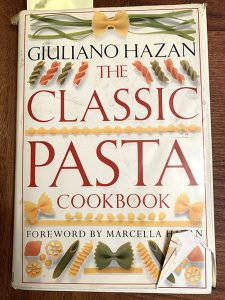 “What? The food of my people?” Auricchio retorted.
“What? The food of my people?” Auricchio retorted.
“We ended up trading more exciting pasta recipes,” said Badowska, who disclosed the contents of a “raid-the-fridge frittata” she made before Auricchio revived her love of pasta.
“We threw in everything we could think of—there was onion, salami, parmesan, wilted parsley, paprika, and even an avocado in there—it wasn’t half bad,” she said.
The recipes Auricchio shared with Badowska came from a battered copy of The Classic Pasta Cookbook, by Giuliano Hazan (Dorling Kindersley, 1993). The book includes her go-to recipe for Bucatini all’ amatriciana, a dish she made every week while working on her dissertation in Paris in the late 1990s so that she could “have a taste of home.”
“In Paris, I used lardons instead of pancetta because every grocery store sold lardons pre-cut and pre-packaged, while pancetta was much harder to find,” she said. “Today, FoodKick brings pancetta right to my door!”
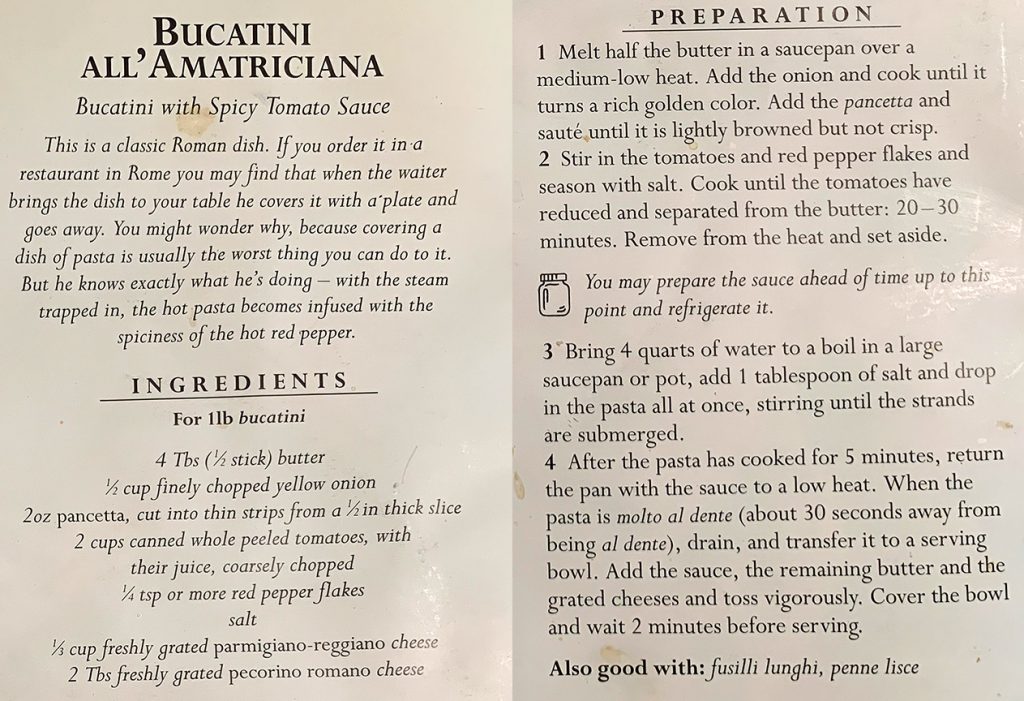
Sophomore Daejah Woolery’s Jamaican Dumplings with Jerk Chicken and Butternut Squash
When Fordham College at Lincoln Center sophomore Daejah Woolery moved off campus she started cooking more. She said she doesn’t always have the time to make elaborate dishes but as a Jamaican, she said, “food is super important to the culture,” so she makes an extra effort to cook from scratch.
“I’m excited to make this for my family this week and show them my slight twist on Jamaican boiled dumplings with chicken!” she said.
- Boiled Dumplings
- 2 cups flour
- 5 teaspoon salt
- 1/4 cup cornmeal
- 1/2 cup cold water
Before you start making the dumplings prep a pot of boiling water. All you need is flour, cornmeal, and water. I’ve made it without cornmeal with great success so, just omit that if you don’t have it.
Combine flour, cornmeal, water and adjust until you have a dough that doesn’t stick to your hands.
Make small disc-like shapes and drop them into boiled water for about 10 minutes. Try not to overcrowd your pot! Leave them to the side. They can remain in the water after they’re done with the burner off.
- Jerk Seasoning
-
- 1 tablespoon garlic powder
- 2 to 3 teaspoons cayenne pepper
- 2 teaspoons onion powder
- 2 teaspoons salt
- 1 teaspoon paprika
- 1 teaspoon ground allspice
- 1/2 teaspoon black pepper
- 1/2 teaspoon dried crushed red pepper
- 1/2 teaspoon ground nutmeg
- 1/4 teaspoon of cinnamon
If you have a bottle of jerk seasoning you are all set, otherwise, you can make a simple version by combining garlic powder, paprika, allspice, cayenne pepper, nutmeg, cinnamon, crushed red pepper, and onion powder.
- Butternut Squash, as much as you’d like.
I often buy my squash frozen and pureed beforehand to give me a little flexibility when I cook. But if you have a whole squash, cut it, boil it, and puree or mash it finely. Heat it up in a saucepan on medium-low heat and add some of your jerk seasonings to taste. Switch to low heat after you see bubbles. Add about a quarter cup of water if you want a thinner sauce.
- Chicken. Again, as much as you’d like, but cut into cubes beforehand.

Season the chicken with jerk seasoning and cook it however you’d like; throw it in the air fryer if you’re in a rush or sauté it on the stove like I usually do.
Once the chicken is cooked, add it to the saucepan with the squash and resist the urge to eat it immediately. Let it simmer together on medium-low heat for 5 minutes. Make sure the chicken gets surrounded by the sauce. The sweet and nutty taste of the squash will interact really well with the jerk seasoning.
Now for plating. Add the dumplings onto a plate and put some chicken and squash directly on top!
Viola! Enjoy!
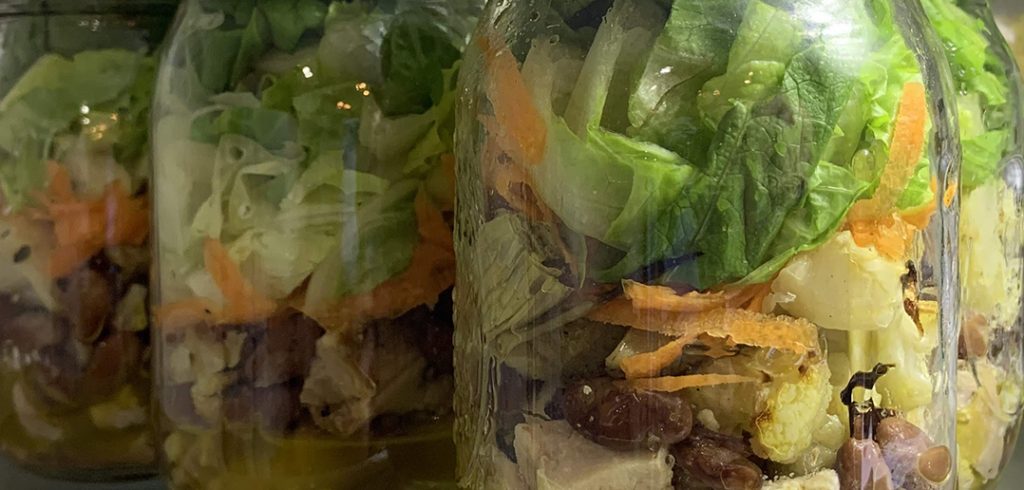
Anne Fernald’s “Whatever” Soup and Weekly Salad Prep
Anne Fernald, Ph.D., professor of English and Women’s, Gender, and Sexuality Studies, said she’s maintained her Sunday night prep cooking for the workweek, a task that she’d rather avoid.
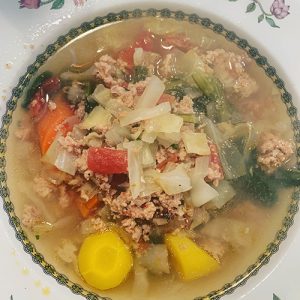
“I realized that if I did not do it, I would revert to my natural diet, which is bread and cheese with some butter,” she said.
She prepares pint-sized mason-jar salads for her and her husband, ensuring healthy lunches for the family, though her two kids don’t indulge too much in the salad.
“I do nothing but teach and cook these days and, in a welcome development, my husband has been cooking a tiny bit, too,” she said.
Her favorite recipe hails from the New York Times’ Samin Nosrat. It’s called Whatever You Want Soup. The soup “serves as a canvas for any kind of chunky soup,” writes Nosrat.
“I used ground turkey, onion, some shredded cabbage, carrots, a tomato, and some green onion,” Fernald said of her version.
Garrett Broad’s Vegan Matzah Brei (aka Fried Matzah)
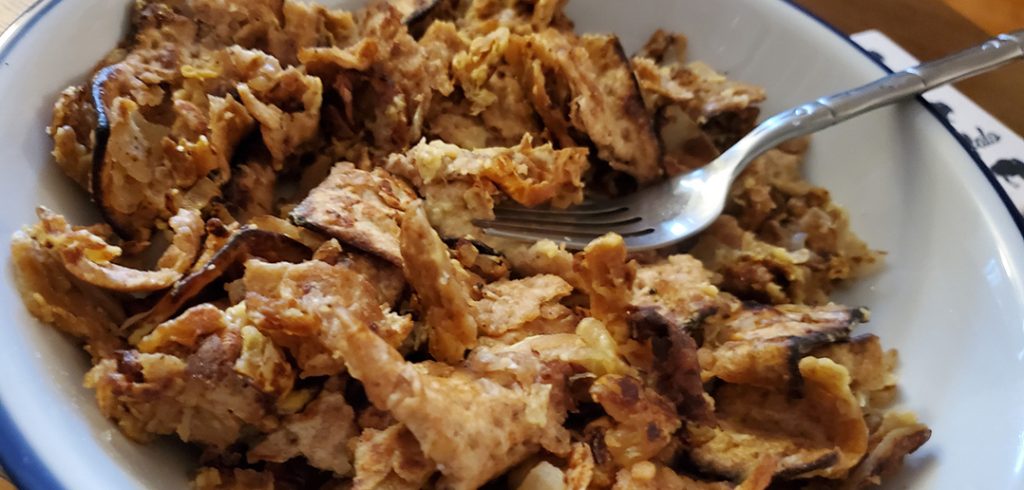
Food justice issues are a specialty of Garrett Broad, Ph.D., assistant professor of communication and media studies. He’s quoted extensively in the media on issues that range from food deserts in underserved communities to farmworkers’ rights, but few ask Broad about what he cooks at home.
He said that since he went vegan, recreating recipes from his family has proved a challenge. But he thinks he’s finally nailed a vegan version of his grandma’s fried matzah.
This makes two full meals or 3 to 4 smaller meals.
- First, break 10 pieces of matzah into squares about 4 by 4 inches.
- Then lightly soak the matzah in a bowl of water for about a minute, setting aside while it’s still a bit crispy.
- Slice a large yellow onion and mince three garlic cloves (or more if you love onions and garlic) and fry in olive oil, then set aside. Then heat up three tablespoons of vegan butter (I use Earth Balance) and fry up half of your matzah for a few minutes on both sides, stirring and flipping frequently. Add a bit of olive oil if it gets too dry.
- Add half of the fried onions and garlic and stir.
- Add an “egg” mixture. I use Just Egg vegan brand (about 5 oz per serving), but if you don’t have that, you can make your own. You’ll have to prepare this in advance: a mix of 10 ounces of silken tofu, three tablespoons of vegan butter, half cup of nondairy milk, salt, pepper, turmeric, onion powder, and garlic powder in a blender.
- Fry up and stir for a few more minutes. Then repeat the process with the other half of the matzah/onions and garlic/egg mixture.
Clint Ramos’ Filipino Chicken Adobo
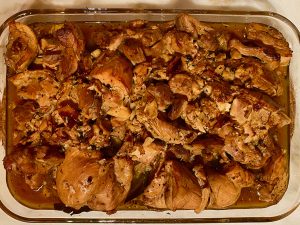
Clint Ramos, head of design and production at Fordham Theatre Program, has won several awards for his set and costume designs including a TONY and an Obie. He posted a photo of Chicken Adobo on his Instagram that prompted inquiries about the recipe. With roots in the activist street theater scene in Manila, he advises that one eat the dish while pondering “how much of what you enjoyed was indigenous or a result of Spanish colonialism.”
Ingredients
- 2.0 lbs boneless chicken thighs (I like skin but you can also do skinless)
- 4 peices dried bay leaves
- 8 tablespoons dark soy sauce (I use Kikkoman)
- 8 tablespoons coconut vinegar (apple cider will also do well)
- 8 cloves garlic peeled and crushed
- 1 1/2 cups water
- 3 tablespoons cooking (canola or any high heat) oil
- 1/4 teaspoon salt (optional—the salinity from the soy may be enough)
- 1 teaspoon whole peppercorns
- 1 teaspoon brown sugar
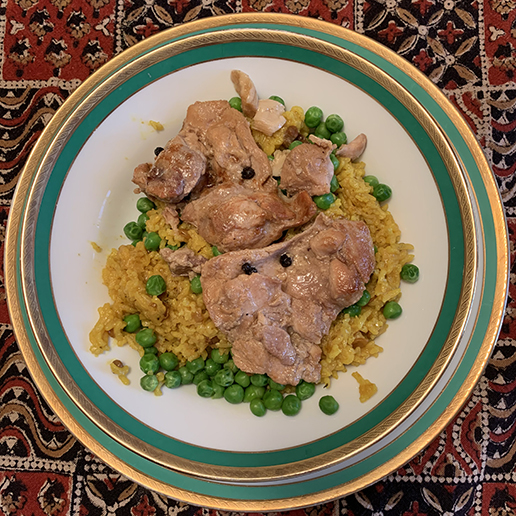
Preparation
- Marinate Chicken in soy, vinegar, and garlic for at least 3 hours or overnight in fridge.
- Make enough brown or white rice for four people.
- Cook adobo
- Separate chicken from marinade, removing as much of the liquid as possible. SAVE ALL OF THE MARINADE (this will be your braising liquid).
- Heat oil in a pan on medium-high heat.
- Brown chicken on both sides. (Two minutes per side)
- In the same pan, pour in the marinade (garlic and all) and water. Bring to a boil.
- Add bay leaves and peppercorns.
- Reduce heat to low to simmer. Simmer for 30 minutes or until chicken is tender. (I completely cover it for 15 mins and let some of the steam out for the remaining 15 with a wooden spoon lodged between lid and pot).
- Important: Watch that the liquid reduces to a slightly thickened sauce but not completely.
- Add sugar and cook for another 5-10 minutes.
- Serve over hot white or brown rice and enjoy!
Taylor Ha’s Cooking Videos: Spaghetti Aglio e Olio and Whipped Coffee (Not Together!)
Longer-lasting foods like pasta have been in high demand across the world, especially in Italy. A classic recipe is spaghetti aglio e olio, which blends garlic, olive oil, and parsley into a simple dish. While quarantining in Westchester County, Fordham graduate student and news staff writer Taylor Ha, followed a spaghetti aglio e olio recipe from allrecipes.com and produced a one-minute video on the cooking process with her mother.
She also recorded herself making another recipe that’s gone viral amid the pandemic. “Whipped coffee,” a four-ingredient milk drink topped with whipped coffee that originally comes from South Korea, was recently featured on TikTok’s trending page with more than 312,000 videos using the hashtag #whippedcoffee, according to ABC News. In their home kitchen, Ha and her mother created their own version of their popular drink, complete with a slo-mo video of the production process.
“Both dishes were delicious and super satisfying to make,” Ha said. “I’ll admit I didn’t actually cook, since I was filming everything, but it was nice to bond with my mom at home.”
Anne Takooshian’s Cookies for Comfort

Anne Takooshian works in human resources for Target, the retail giant that has been deemed an essential business during the pandemic. Anne is married to Harold Takooshian, Ph.D., professor of psychology, who examines the impacts of city life. Harold said that through his research he has observed that in times of strife, citizens tend to bolster community. For her part, Anne has been baking a different batch of cookies every day, which she then hands out in baggies to co-workers who pass by her desk.
“I enjoy baking, and it brings joy to others,” said Anne.
Despite Anne’s modesty, her husband sees a larger domino effect on the mental health of his wife and others. He said that after a long day at work, the act of baking takes time and patience.
“It is relaxing to most of the five senses—the feel of the dough, sight and smells as it bakes,” said Harold. “She has control of her kitchen in an uncontrollable world, a chance to try creative new recipes, and tangible positive results at evening’s end, in time for the next morning.”
He added that in return her co-workers devise their own contributions to the workplace. One grateful co-worker gave Anne four pounds of butter for future cookies. He noted that small acts of kindness by one lead to groups aiming to make a positive difference.
Conor O’Kane’s Dinner Table Conversation
Conor O’Kane, dean of first-year students at Fordham College at Lincoln Center, said he and his family have been trying to focus on “healthy, fun, and economical meals,” which have included grilled pineapple pork chops with a brown sugar/soy glaze and grilled green beans and garlic with long grain rice. A sautéed salmon with a horseradish/apricot jam compote with sweet potatoes and broccoli was was also a hit.
“With two young kids, those were wins we took to the bank,” he said.
While he didn’t get into the specifics about the recipes, O’Kane said he couldn’t help but focus on how meals have taken on a new character. As former director of campus ministry, he noted a spiritual dimension.
“They’ve become unhurried and more relaxing affairs and very important beats in a day,” he said.
But the meals have also taken on a new level of intimacy as well.
“As we’re together all day the conversation has shifted from ‘What did you do today?’ to ‘How are you today?’ and the impact has been noticeable.”
He said when the pandemic ends, he hopes what his family has learned from their time together doesn’t dissipate with the return to a fast-paced urban life.
“I’m hopeful that we can emerge from our social isolation changed, and for the better; if we return to life as it was and the pace at which we lived it, something will be lost,” he said. “The reverence, community—and communion—that we’ve found at meals is one of the things I’d like to bring forward for myself and my family. Salmon or sandwiches—we’ve rediscovered something I didn’t know was lost. And I’m grateful for that.”

